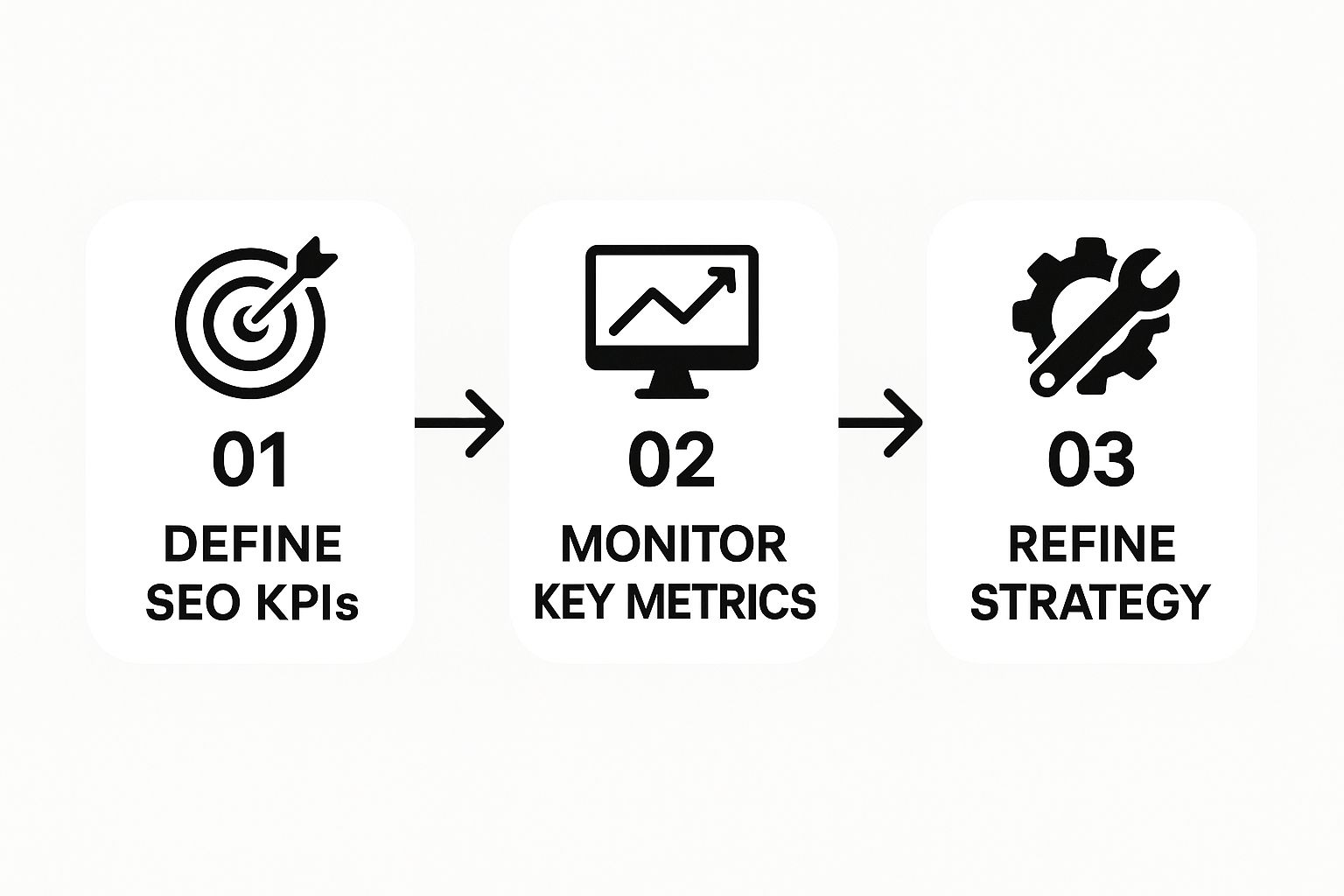Why Your Ecommerce SEO Strategy Is Your Best Investment
Let's be honest, seeing your competitors splash cash on ads can be a little unsettling. But here's a secret: the savviest ecommerce brands are quietly building empires of organic traffic. I've seen firsthand how store owners completely flipped their businesses by prioritizing SEO. They discovered that ranking for tons of keywords isn't just a vanity metric—it's a direct pipeline to free, monthly revenue. In fact, as of 2025, the average ecommerce brand ranked for 1,783 keywords, pulling in an estimated 9,625 organic visits per month. That's like getting nearly £11,800 worth of paid search ads, absolutely free! Discover more insights about ecommerce SEO statistics.
The Hidden Trap of Ad Dependency
So many ecommerce businesses get stuck in the paid advertising trap. Sure, ads can give you a quick bump, but they become this constant expense. It's like renting a shop: you pay for the visibility, but you don't own the property. Stop paying, and the foot traffic vanishes. This dependence nibbles away at your profits and makes you vulnerable to market shifts and rising ad costs.
Organic Traffic: The Gift That Keeps on Giving
Organic traffic, on the other hand, is like owning your shop. You invest in building a solid foundation – your ecommerce SEO strategy – and it keeps bringing in customers over the long haul. Every blog post, every product page tweak, every backlink is another brick in that foundation. The more you build, the stronger your online presence becomes, and the less you need to shell out for expensive ads.
Calculating Your True SEO ROI
Figuring out your SEO ROI isn't as straightforward as with paid ads. With ads, you track clicks and conversions. With SEO, the benefits snowball over time. Don't just look at the immediate traffic, think about the long game: brand building, authority, and sustainable growth.
For example, imagine investing £1,000 in top-notch content optimized for a specific product category. It might not lead to instant sales, but it will attract the right kind of traffic, earn backlinks, and position you as an expert. Over time, that content becomes a valuable asset, steadily bringing in organic traffic and contributing to conversions long after the initial investment. It’s a long-term play that pays off big.
Let's look at the potential cost savings in more detail:
To illustrate the long-term cost savings, let's compare the cost of organic traffic with the equivalent cost of paid advertising, assuming an average cost-per-click and conversion rate:
Organic Traffic vs Paid Advertising Cost Comparison
| Traffic Source | Monthly Visits | Equivalent Paid Cost | Organic Investment | Cost Savings |
|---|---|---|---|---|
| Organic Search | 9,625 | £11,800 | £1,000 (Content Creation) | £10,800 |
This table highlights the significant cost savings of investing in organic SEO. While the initial investment in content creation might seem substantial, the long-term return in terms of free traffic far outweighs the cost of equivalent paid advertising campaigns.
Real-World Transformations
I’ve spoken with ecommerce founders who significantly cut their ad spend and poured those resources into a robust SEO strategy. The results? Remarkable. They didn't just see more traffic; they saw better traffic. Organic visitors are often warmer leads, actively searching for what they need, leading to higher conversion rates. These businesses discovered that focusing on the long game of SEO created sustainable growth that paid advertising simply couldn't match. They own their storefront now, and it’s open 24/7.
Finding Keywords That Actually Convert Customers
Forget chasing vanity metrics like those high-volume keywords everyone’s after. The ecommerce brands that really kill it focus on something much more valuable: understanding their customer’s search behavior when they’re ready to buy. This means going deep into the customer journey, from that initial spark of interest all the way to hitting that glorious "add to cart" button. Let me share how the pros uncover these high-converting keywords, including those golden long-tail opportunities often missed by the competition.
Targeting the Customer Journey With Keywords
Think about how you shop online. You probably start with a broad search, then narrow it down as you learn more. This is the customer journey, and each stage needs different keywords. For example, someone searching for "winter boots" is just browsing. But someone searching for "best waterproof winter boots for hiking" is practically ready to pull out their credit card. See the difference? The second one is a long-tail keyword dripping with buying intent. These highly specific searches are where the conversions really happen.
Unearthing Product-Specific and Seasonal Gems
Every product has its own unique set of keywords. Don't just optimize for "blue dress"—get granular! What kind of blue dress? Is it a "maxi dress," a "cocktail dress," or a "wedding guest dress"? Adding details like material ("silk blue dress") or features ("blue dress with pockets") can drastically improve your visibility to the right customers.
Seasonal opportunities are another goldmine waiting to be tapped. Think "Halloween costumes" in October or "Christmas gifts for her" in December. Optimizing product pages and creating timely content around these trends can drive a surge of targeted traffic during those crucial peak buying periods.
Prioritizing Keywords for Profit, Not Just Traffic

This screenshot from Ahrefs shows how keyword research tools can reveal some seriously valuable data. Look at the Keyword Difficulty (KD) score—this tells you how hard it is to rank for a specific keyword. A lower KD means less competition, giving you a fighting chance to hit that first page. Equally important is the search volume—how many people are actually searching for that term every month? Ahrefs even gives you “Traffic Potential,” estimating how much organic traffic a top-ranking page could get.
The real lesson here? Effective keyword research isn't about chasing huge search volume. It’s about finding that sweet spot: keywords with decent search volume, manageable competition, and high buying intent. That’s the magic formula for a profitable ecommerce SEO strategy. Focusing on these metrics helps you attract customers who are ready to buy, not just browse. This targeted approach maximizes your ROI and sets your store up for lasting success. By mapping these high-intent keywords to different product lines, you ensure every corner of your store is optimized for conversions, not just clicks. Now, let's talk about those technical issues that can tank your rankings before you even get started…
Fixing The Technical Issues Killing Your Rankings
I've seen so many ecommerce businesses pour their heart into content and keywords, only to be tripped up by technical SEO problems they didn't even know existed. It's like building a gorgeous shop in the middle of nowhere – nobody's going to find it! Sadly, the average ecommerce site only scores around 67/100 on Google’s performance tests. And get this: 90% of the lowest-performing sites have user experience (UX) issues. That means there's a huge opportunity waiting to be tapped. Learn more about ecommerce SEO statistics.
Site Speed: The Need for Speed
Site speed is everything. I can't tell you how many times I've seen potential customers bounce because a page took too long to load. It's the online equivalent of a shop assistant ignoring a customer – they'll just walk out. Every second counts, and every extra second waiting is another potential sale down the drain. Site speed optimization is about making your online store a well-oiled machine, loading quickly and smoothly to keep customers happy and ready to shop.
Mobile Responsiveness: Thumb-Friendly Shopping
Let's be real: everyone's glued to their phones these days. If your online store isn't mobile-responsive, you're missing out on a huge chunk of your potential audience. Imagine a shop with a door too small to enter – that's what a non-responsive site feels like to a mobile user. Plus, Google loves mobile-friendly websites, so it impacts your search rankings too.
Crawlability: Helping Google Find Your Products
Even with a lightning-fast, mobile-friendly site, your products won't sell if search engines can't find them. Crawlability means making sure Google’s bots can easily navigate your website. Think clear signage and well-organized aisles in a physical store - that’s what you want for your site structure. If Google can't find your products, neither can your customers.
Structured Data: Making Your Listings Shine
Have you ever seen those product listings on Google with star ratings and prices right there in the search results? That's the magic of structured data. It's like giving Google a detailed catalog of your products, allowing your listings to pop and giving shoppers the info they need to click. You don’t need to be a coding whiz, just understand how structured data works and why it's so important for your technical team to implement it. Check out our guide on SEO quick wins for some easy improvements.
Platform-Specific Issues and Technical Audits
Each ecommerce platform has its own set of technical SEO challenges and opportunities. Whether you’re on Shopify, WooCommerce, or another platform, knowing its ins and outs is critical. Regular technical audits, using tools like That’s Rank!, are like health checkups for your website. They uncover hidden issues and prevent small problems from snowballing into major disasters.
Addressing these technical aspects isn't about becoming a developer overnight; it's about knowing what makes a difference in ecommerce SEO and working with your tech team to get it done. I've seen businesses see massive improvements in rankings and traffic just by fixing a few key technical issues. It's like flipping a switch and watching your store suddenly come alive.
Creating Content That Brings Traffic and Sales Together

Ecommerce content marketing isn't about churning out fluffy blog posts and hoping for the best. It’s about creating genuinely useful resources that speak to your customers’ pain points, while subtly showcasing how your products provide the perfect solution. The brands that really nail this understand how to build an ecommerce SEO strategy that boosts search rankings and drives those all-important sales.
Crafting Content for Every Stage of the Customer Journey
Think about the journey a customer takes before they buy. They might start researching a problem, then compare solutions, and finally, make that purchase decision. Your content needs to be there for them at each stage.
- Early Stage (Problem Awareness): Think blog posts, articles, and videos that educate potential customers about their problems. For example, if you're selling running shoes, you might create content about common running injuries or choosing the right running form.
- Mid-Stage (Solution Exploration): Buying guides, comparison articles, and product reviews are your friends here. This is where you position your products alongside the competition, highlighting what makes yours special.
- Late Stage (Purchase Decision): Detailed product pages, customer testimonials, and special offers are key to sealing the deal. And don't forget about optimizing your checkout process – a smooth checkout is crucial for minimizing cart abandonment and boosting completed purchases. For some real practical tips, check out this helpful article about ecommerce checkout optimization.
Planning, Creating, and Repurposing Content Like a Pro
Creating a consistent stream of high-quality content can feel daunting, but it doesn't have to be. Here are a few tips I've picked up along the way:
- Develop a Content Calendar: Planning your content in advance, focusing on key themes and seasonal opportunities, keeps you organized and ensures a consistent flow of valuable resources. Want even more insights? Check out our guide on ecommerce SEO tips.
- Establish a Creation Workflow: Streamline your content creation process, from brainstorming and writing to editing and publishing. This might involve collaborating with freelance writers, designers, or video editors.
- Repurpose Existing Content: Squeeze every drop of value from your content by repurposing it into different formats. Turn a blog post into an infographic, a video, or a series of social media updates. It's a great way to leverage your existing work and reach a wider audience.
Identifying Content Gaps and Optimizing for Conversions
One of the most effective strategies is identifying content gaps your competitors haven't addressed. What questions are your customers asking that aren't being answered? What valuable resources are missing in your niche? Filling these gaps positions you as an authority and attracts highly targeted traffic. Remember, the more comprehensive your content, the more likely it is to attract traffic and build valuable backlinks. In fact, articles over 3,000 words generate triple the traffic of standard 1,400-word posts, and they also earn four times more shares and 3.5 times more backlinks. Want to dive deeper into these stats? Discover more insights about SEO statistics.
Finally, don't forget to optimize your product pages for both search engines and conversions. Use compelling product descriptions, high-quality images, and clear calls to action. Make it easy for customers to find what they need and complete their purchase. It’s a balancing act, optimizing for SEO while keeping things natural and customer-focused. But the better you get at merging these goals, the more successful your ecommerce SEO strategy will be.
Building Authority Through Smart Link Building Tactics

Link building for ecommerce can feel like a totally different ballgame. So many store owners are stuck with outdated tactics, sending out mass outreach emails that go straight to spam. The real secret? Quality over quantity, especially in the competitive ecommerce world. Think about this: the average ecommerce backlink has a Domain Rating of only 28. But links earned through strategic digital PR have an average Domain Rating of 46. That's a huge difference, and it shows how much Google values real authority. It’s no wonder that 52% of ecommerce websites are already on board with digital PR for link building. These ecommerce SEO statistics might surprise you!
Leveraging Your Products and Customer Stories
Ditch the generic outreach. What makes your store special? Your products and the people who use them! I’ve seen brands skyrocket their link profiles by showcasing real customer success stories. Imagine a sustainable clothing company partnering with environmental bloggers. They could highlight how the clothes reduce waste, creating a genuine story that resonates with the blogger’s audience and attracts journalists.
Strategic Partnerships That Benefit Everyone
Strategic partnerships are another goldmine for high-quality backlinks. Forget “link exchange” – think “mutual benefit.” Who else operates in your niche? Maybe a kitchenware store could team up with a food blogger, offering products for recipe demos in exchange for a link. This isn't just about getting a link; it's about building relationships that broaden your audience.
Creating Linkable Assets That Generate Buzz
Think beyond basic blog posts. Create valuable assets that people want to link to. A solid ecommerce content strategy is essential for driving traffic and sales by aligning your content with customer needs. Consider developing in-depth guides, original research, or interactive tools that become go-to resources in your industry. I once worked with a furniture store that built a free online room planner. It got tons of backlinks from design blogs and websites, significantly boosting their organic traffic.
Measuring Link Building ROI and Avoiding Pitfalls
Don’t just count backlinks; analyze their quality and how they impact your traffic and rankings. Tracking your link building efforts allows you to see which strategies are working best and adjust your approach accordingly. Stay away from shady tactics like buying links. These shortcuts can tank your site’s authority and even get you penalized by Google. Focus on building real relationships and creating valuable content that earns links naturally. It takes longer, but the payoff is huge.
Let's talk about measuring the effectiveness of different link building strategies. The table below shows a comparison of a few approaches and their impact on Domain Rating:
| Strategy Type | Average Domain Rating | Success Rate | Time Investment | Cost |
|---|---|---|---|---|
| Guest Blogging | 30-40 | Medium | High | Low-Medium |
| Broken Link Building | 25-35 | Medium | Medium | Low |
| Digital PR & Earned Media | 45-60 | High | High | Medium-High |
| Product Reviews & Giveaways | 20-30 | Low-Medium | Low-Medium | Medium |
| Strategic Partnerships | 40-50 | Medium-High | Medium | Variable |
This table illustrates how strategies like Digital PR and Strategic Partnerships, while potentially requiring more time and resources, tend to yield higher Domain Rating backlinks, contributing more significantly to website authority. Less resource-intensive strategies like Broken Link Building and Product Reviews can still be valuable, but typically generate lower DR links. The key is to find the right mix for your business.
Staying Ahead Of Search Engine Changes That Matter
Search engine optimization (SEO) is a constantly moving target. What drove rankings last year might not even register today. Instead of stressing over every algorithm update, savvy ecommerce businesses are getting ahead of the game. They're not reacting, they're proactively evolving their SEO strategies.
Embracing the Future of Search
Think about how you search online compared to even a few years ago. Voice search using tools like Alexa or Google Assistant, image search, and AI-powered search are becoming increasingly common. Successful ecommerce brands are already optimizing for these changes. They're testing how to make their products pop up in visual search results and tweaking their content to match voice search queries. These brands get it: staying ahead of the curve means being where your customers are, no matter how they search.
Optimizing for Featured Snippets and Zero-Click Searches
You've probably noticed that Google sometimes gives you answers right there on the search results page, right? These featured snippets are digital gold. Optimizing your content to grab these top spots can really boost visibility and traffic. But there’s a catch. Zero-click searches, where users get the info they need without clicking through to a website, are on the rise. The trick is to balance giving users useful information directly in the search results, while still making them want to click through to your store to learn more and, you know, actually buy something.
In 2025, AI integration in SEO changed everything. For example, a whopping 52% of the content in Google’s AI Overviews comes from pages already ranking in the top 10 organic search results. This shows how vital it is to consistently create high-quality, informative content that works for both people and search engines. Plus, with 92.3% of internet users on mobile devices, having a mobile-friendly site isn’t a nice-to-have anymore – it's a necessity. Learn more about SEO statistics here.
E-E-A-T and Your Ecommerce Site
Google's E-E-A-T guidelines (Experience, Expertise, Authoritativeness, and Trustworthiness) are especially important for ecommerce. Building trust is crucial when you’re asking for people's money. Think about it – would you buy from a website that looks shady? Showcasing customer reviews, highlighting product certifications, and using expert content can make a big difference in building that all-important credibility. E-E-A-T is like a seal of approval for your online store, telling potential customers you’re the real deal.
Future-Proofing Your Strategy
While keeping up with the latest trends is essential, don’t forget the SEO basics. Solid keyword research, great content, and a technically sound website are always the foundation of a successful ecommerce SEO strategy. It's about combining the tried-and-true with the cutting-edge. Building a strategy that's strong yet flexible enough to adapt to the ever-changing search landscape. Think of it like building a house with a solid foundation that can weather any storm. So, now that we’ve got the big picture, let’s get down to brass tacks and turn this info into an actionable plan.
Your Practical Roadmap To Ecommerce SEO Success

This infographic shows how you should approach your ecommerce SEO strategy: define your Key Performance Indicators (KPIs), watch your metrics, and then tweak your strategy based on the data. See? It's a cycle. Just like SEO itself. It’s not a one-and-done deal. You've got to constantly monitor, analyze, and refine what you're doing to keep up with Google and get the best return on your investment. Want to really stay ahead of the game? Keep learning! Here are some great Ecommerce SEO Tips to get you started.
Building Your Action Plan
Alright, let's get down to brass tacks. You need a solid action plan, broken down into digestible chunks. Think of it like this:
- Phase 1: Audit and Quick Wins: First, you've got to know where you stand. A thorough SEO audit is like a check-up for your website. It helps you find technical issues, content gaps, and those easy wins you can grab right away. Think broken links, messy page titles, or a slow website. Fix those first.
- Phase 2: Keyword Strategy and Content Creation: Once you know what needs fixing, you can fine-tune your keyword strategy and map out a content calendar. Focus on creating truly helpful content that targets those high-intent keywords—the ones that show a customer is ready to buy. And always, always address what your customers actually need.
- Phase 3: Link Building and Authority: Links are like votes of confidence from other websites. Focus on quality over quantity. You want backlinks from authoritative sites in your industry. Think creative campaigns and strategic partnerships. Need some inspiration? Check out this article on how to measure SEO success. It dives into proving the value of your SEO efforts.
- Phase 4: Ongoing Monitoring and Refinement: SEO is a long game. Regularly track your performance with tools like Google Analytics and Google Search Console. Analyze the data and adjust your strategy as needed. This constant tweaking is how you stay on top and maximize your ROI.
Budgeting and Resources
Budgeting is key. Spread your resources wisely across different SEO activities. Figure out what you can handle in-house and when it makes sense to bring in the experts. Investing in the right tools can really streamline your workflow and help you track progress.
Maintaining Momentum
Ecommerce SEO is a marathon, not a sprint. Don't get discouraged by bumps in the road. Focus on the long game. Celebrate the wins, learn from the losses, and keep pushing forward. Ready to take your ecommerce SEO to the next level? That's Rank! has some powerful tools to help you track your rankings, keep an eye on your competition, and optimize your website for maximum visibility. Start your free trial today!